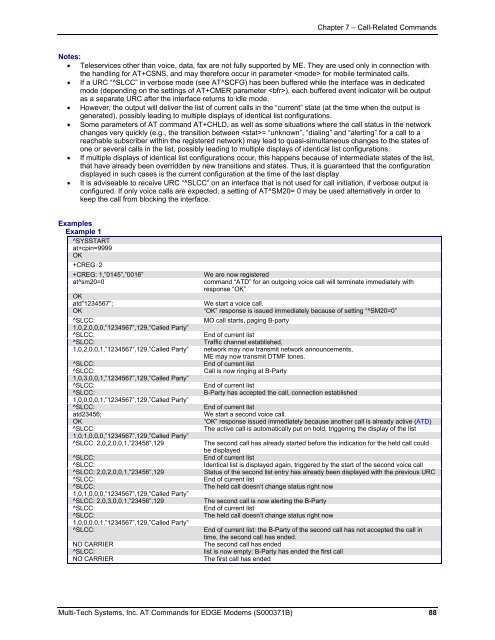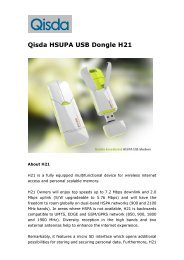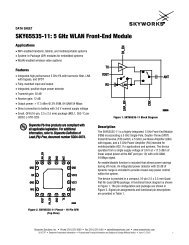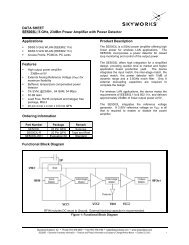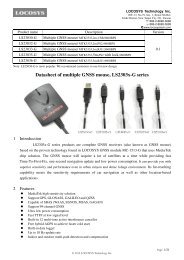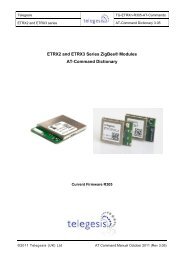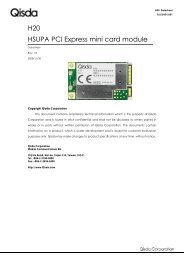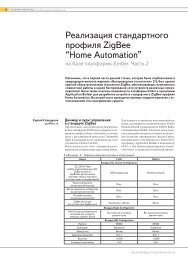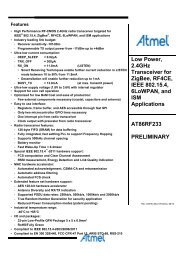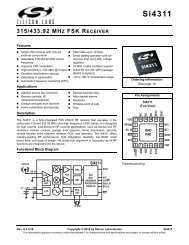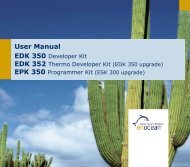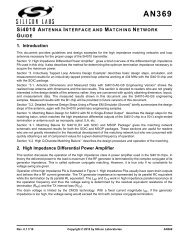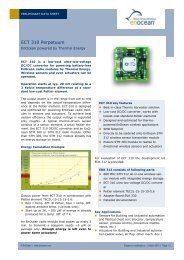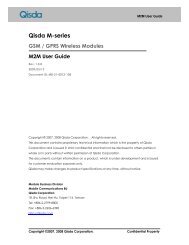AT Command Reference Guide for EDGE Wireless ... - wless.ru
AT Command Reference Guide for EDGE Wireless ... - wless.ru
AT Command Reference Guide for EDGE Wireless ... - wless.ru
Create successful ePaper yourself
Turn your PDF publications into a flip-book with our unique Google optimized e-Paper software.
Chapter 7 – Call-Related <strong>Command</strong>s<br />
Notes:<br />
• Teleservices other than voice, data, fax are not fully supported by ME. They are used only in connection with<br />
the handling <strong>for</strong> <strong>AT</strong>+CSNS, and may there<strong>for</strong>e occur in parameter <strong>for</strong> mobile terminated calls.<br />
• If a URC “^SLCC” in verbose mode (see <strong>AT</strong>^SCFG) has been buffered while the interface was in dedicated<br />
mode (depending on the settings of <strong>AT</strong>+CMER parameter ), each buffered event indicator will be output<br />
as a separate URC after the interface returns to idle mode.<br />
• However, the output will deliver the list of current calls in the “current” state (at the time when the output is<br />
generated), possibly leading to multiple displays of identical list configurations.<br />
• Some parameters of <strong>AT</strong> command <strong>AT</strong>+CHLD, as well as some situations where the call status in the network<br />
changes very quickly (e.g., the transition between = “unknown”, “dialing” and “alerting” <strong>for</strong> a call to a<br />
reachable subscriber within the registered network) may lead to quasi-simultaneous changes to the states of<br />
one or several calls in the list, possibly leading to multiple displays of identical list configurations.<br />
• If multiple displays of identical list configurations occur, this happens because of intermediate states of the list,<br />
that have already been overridden by new transitions and states. Thus, it is guaranteed that the configuration<br />
displayed in such cases is the current configuration at the time of the last display.<br />
• It is adviseable to receive URC “^SLCC” on an interface that is not used <strong>for</strong> call initiation, if verbose output is<br />
configured. If only voice calls are expected, a setting of <strong>AT</strong>^SM20= 0 may be used alternatively in order to<br />
keep the call from blocking the interface.<br />
Examples<br />
Example 1<br />
^SYSSTART<br />
at+cpin=9999<br />
OK<br />
+CREG: 2<br />
+CREG: 1,”0145”,”0016”<br />
at^sm20=0<br />
OK<br />
atd”1234567”;<br />
OK<br />
^SLCC:<br />
1,0,2,0,0,0,”1234567”,129,”Called Party”<br />
^SLCC:<br />
^SLCC:<br />
1,0,2,0,0,1,”1234567”,129,”Called Party”<br />
^SLCC:<br />
^SLCC:<br />
1,0,3,0,0,1,”1234567”,129,”Called Party”<br />
^SLCC:<br />
^SLCC:<br />
1,0,0,0,0,1,”1234567”,129,”Called Party”<br />
^SLCC:<br />
atd23456;<br />
OK<br />
^SLCC:<br />
1,0,1,0,0,0,”1234567”,129,”Called Party”<br />
^SLCC: 2,0,2,0,0,1,”23456”,129<br />
^SLCC:<br />
^SLCC:<br />
^SLCC: 2,0,2,0,0,1,”23456”,129<br />
^SLCC:<br />
^SLCC:<br />
1,0,1,0,0,0,”1234567”,129,”Called Party”<br />
^SLCC: 2,0,3,0,0,1,”23456”,129<br />
^SLCC:<br />
^SLCC:<br />
1,0,0,0,0,1,”1234567”,129,”Called Party”<br />
^SLCC:<br />
NO CARRIER<br />
^SLCC:<br />
NO CARRIER<br />
We are now registered<br />
command “<strong>AT</strong>D” <strong>for</strong> an outgoing voice call will terminate immediately with<br />
response “OK”<br />
We start a voice call.<br />
“OK” response is issued immediately because of setting “^SM20=0”<br />
MO call starts, paging B-party<br />
End of current list<br />
Traffic channel established,<br />
network may now transmit network announcements,<br />
ME may now transmit DTMF tones.<br />
End of current list<br />
Call is now ringing at B-Party<br />
End of current list<br />
B-Party has accepted the call, connection established<br />
End of current list<br />
We start a second voice call.<br />
“OK” response issued immediately because another call is already active (<strong>AT</strong>D)<br />
The active call is automatically put on hold, triggering the display of the list<br />
The second call has already started be<strong>for</strong>e the indication <strong>for</strong> the held call could<br />
be displayed<br />
End of current list<br />
Identical list is displayed again, triggered by the start of the second voice call<br />
Status of the second list entry has already been displayed with the previous URC<br />
End of current list<br />
The held call doesn’t change status right now<br />
The second call is now alerting the B-Party<br />
End of current list<br />
The held call doesn’t change status right now<br />
End of current list: the B-Party of the second call has not accepted the call in<br />
time, the second call has ended.<br />
The second call has ended<br />
list is now empty: B-Party has ended the first call<br />
The first call has ended<br />
Multi-Tech Systems, Inc. <strong>AT</strong> <strong>Command</strong>s <strong>for</strong> <strong>EDGE</strong> Modems (S000371B) 88


